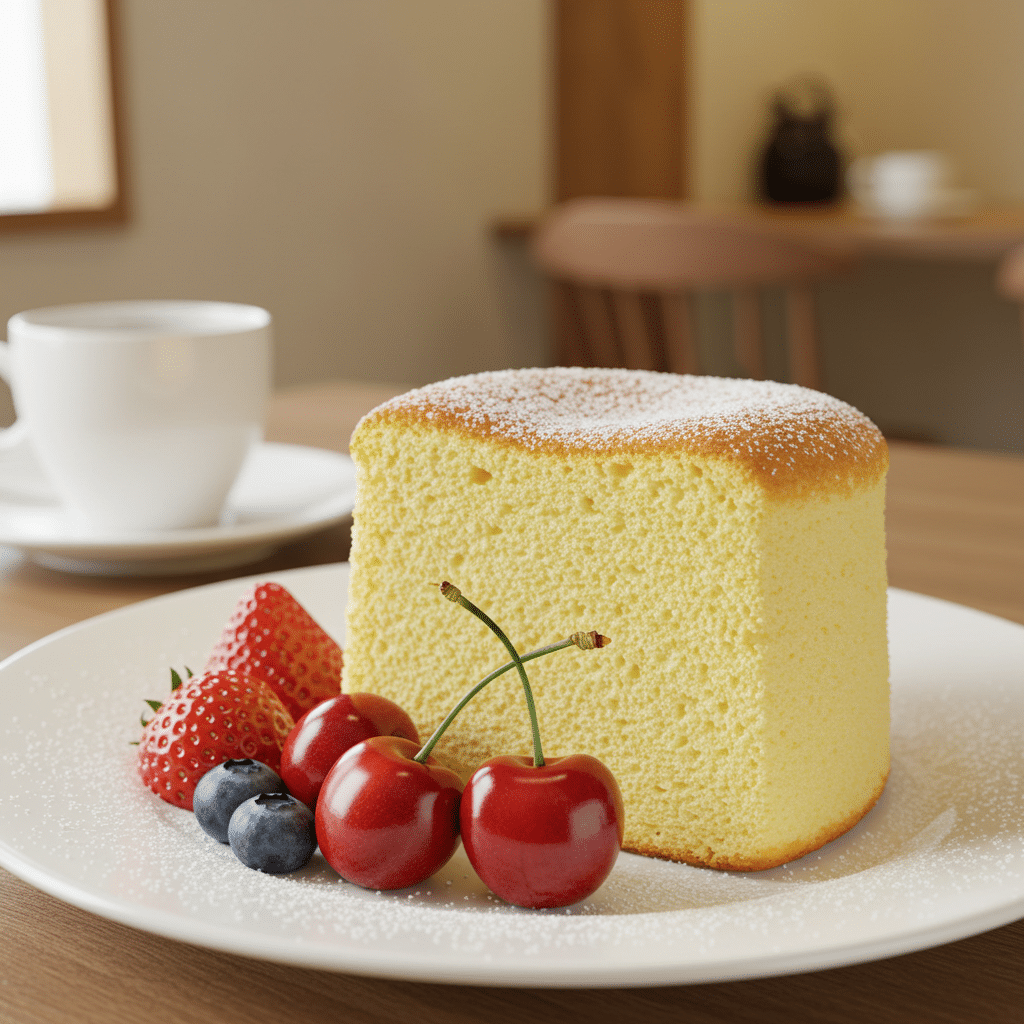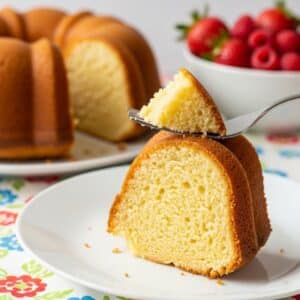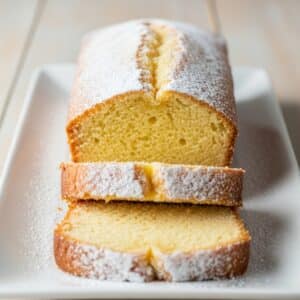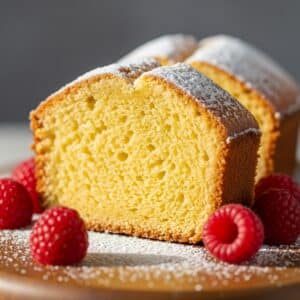The Light & Fluffy Sponge Cake Recipe is a timeless classic in baking, admired for its simplicity, versatility, and elegance. With just a handful of ingredients, eggs, sugar, flour, and a little butter, you can create a cake that’s light as air yet full of flavor. Unlike richer cakes such as pound cake or butter cake, sponge cake derives its delicate texture from the volume created when eggs and sugar are whipped together. This technique produces a soft, tender crumb that practically melts in your mouth.
Sponge cake is beloved worldwide, from British afternoon teas to Japanese roll cakes, because it adapts beautifully to countless occasions. It can stand alone with a dusting of powdered sugar, pair with fruit and cream for a refreshing dessert, or serve as the base for elaborate layered cakes. Its neutral flavor makes it a canvas for creativity, while its lightness ensures it never feels too heavy.
🧾 Want to keep this recipe for later? Download your printable PDF version now and enjoy it anytime!
📥 Download Recipe PDF✅ Print-friendly • 🕒 Save for later • 📱 Mobile-accessible
💡 Want more like this? Subscribe to our weekly printable recipes!
In this article, we’ll explore why sponge cake has remained a staple, detail the key ingredients, break down the step-by-step instructions, and provide tips for achieving the perfect texture. You’ll also discover creative serving ideas, storage guidance, nutritional notes, and an FAQ addressing common baking questions. By the end, you’ll have the knowledge and confidence to bake a sponge cake that’s consistently light, fluffy, and delicious.
Why Bake a Light & Fluffy Sponge Cake
A Cake with History and Heritage
Sponge cake has deep roots in European baking traditions, dating back to the Renaissance. Its appeal lies in its simplicity: no extravagant ingredients, just skillful use of eggs and sugar to create volume. Over the centuries, it became a foundation for countless regional desserts, from Italian Pan di Spagna to French génoise. Today, it’s cherished across cultures for the same reasons it was centuries ago, lightness, adaptability, and elegance.
Perfect for Every Occasion
Few cakes are as adaptable as sponge cake. It can be served casually with afternoon tea, layered with fruit for summer picnics, or dressed up with frosting for birthdays. Like the Ultimate Chocolate Cake Recipe, it seamlessly fits both informal and formal settings. Its neutral taste makes it the ideal base for custom flavors, whether citrus zest, almond extract, or cocoa powder. This versatility ensures it remains a kitchen essential for bakers everywhere.
Print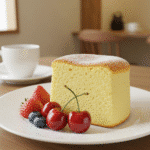
Light & Fluffy Sponge Cake Recipe
- Total Time: 45 minutes
- Yield: 8 servings 1x
- Diet: Vegetarian
Description
This Light & Fluffy Sponge Cake Recipe is a timeless classic with a delicate crumb and airy texture. Perfect on its own with a dusting of powdered sugar, or as a base for layered desserts, trifles, and roll cakes.
Ingredients
4 large eggs, at room temperature
1 cup granulated sugar
1 teaspoon vanilla extract
1 cup all-purpose flour
1 teaspoon baking powder
1/4 teaspoon salt
1/4 cup unsalted butter, melted and cooled
Powdered sugar for dusting (optional)
Instructions
1. Preheat oven to 350°F (175°C). Grease and flour an 8-inch round cake pan or line with parchment paper.
2. In a large mixing bowl, beat eggs and sugar on high speed for 5–7 minutes until thick, pale, and tripled in volume. Stir in vanilla extract.
3. In a separate bowl, sift together flour, baking powder, and salt.
4. Gently fold the dry ingredients into the egg mixture using a spatula, being careful not to deflate the batter.
5. Drizzle melted butter around the edges of the bowl and fold it in gently until just combined.
6. Pour the batter into the prepared cake pan and smooth the top.
7. Bake for 25–30 minutes, or until a toothpick inserted in the center comes out clean.
8. Cool in the pan for 10 minutes, then transfer to a wire rack to cool completely.
9. Dust with powdered sugar before serving, if desired.
Notes
For best results, use room-temperature eggs as they whip to greater volume.
Avoid overbaking to keep the sponge moist and tender.
This cake freezes well for up to 3 months when wrapped tightly.
Use as a base for trifles, Swiss rolls, or layered celebration cakes.
- Prep Time: 15 minutes
- Cook Time: 30 minutes
- Category: Dessert
- Method: Baking
- Cuisine: European
Nutrition
- Serving Size: 1 slice
- Calories: 210
- Sugar: 18g
- Sodium: 120mg
- Fat: 7g
- Saturated Fat: 4g
- Unsaturated Fat: 2g
- Trans Fat: 0g
- Carbohydrates: 30g
- Fiber: 0g
- Protein: 5g
- Cholesterol: 105mg
Key Ingredients for Success
Eggs and Sugar: The Power Duo
Eggs are the cornerstone of sponge cake. Beaten with sugar, they create the volume that gives sponge its name. Using room-temperature eggs is essential because they whip more efficiently, trapping more air. Sugar doesn’t just sweeten the mixture; it stabilizes the foam, ensuring the whipped eggs hold their volume during baking. Together, eggs and sugar transform into a pale, fluffy base that defines the cake’s lightness.
Supporting Players: Flour and Butter
All-purpose flour provides structure, while baking powder gives an extra lift. Salt, though used sparingly, sharpens the flavors and balances sweetness. Melted butter, folded in at the end, enriches the batter slightly without weighing it down. Each ingredient plays a precise role, and balance is key. Too much flour makes the cake heavy, while overmixing butter can deflate the airy foam. Precision ensures the final result is light yet flavorful.
Step-by-Step Baking Instructions
Preparing the Batter
Start by preheating the oven to 350°F (175°C). Grease and flour an 8-inch cake pan, or line it with parchment for easy release. Beat the eggs and sugar together for 5–7 minutes until thick, pale, and tripled in volume. This is called “ribbon stage,” where the batter falls in ribbons that slowly dissolve. Stir in vanilla extract for a subtle aroma.
Folding and Baking
In a separate bowl, sift together flour, baking powder, and salt. Gently fold the dry ingredients into the whipped eggs, taking care not to deflate the mixture. Drizzle melted butter around the edges and fold it in with a spatula. Pour the batter into the prepared pan, smooth the top, and bake 25–30 minutes. The cake is ready when a toothpick inserted into the center comes out clean.
Tips for Perfect Texture
Beating the Eggs to Ribbon Stage
The volume of sponge cake comes from properly beaten eggs. At ribbon stage, the mixture should be thick enough to form patterns on the surface before disappearing. Under-beating leads to a flat cake, while over-beating can make the batter dry and unstable. Use an electric mixer on high speed, but watch carefully to stop at the right moment.
Folding with Care
When incorporating flour and butter, fold gently with a spatula in broad, sweeping motions. This preserves the tiny air bubbles that keep the cake light. Stirring too vigorously knocks out air, resulting in a dense texture. A silicone spatula is ideal for folding, as it glides smoothly through the batter. Mastering this technique ensures your sponge cake remains fluffy every time.
Creative Serving Ideas
Simple and Elegant Options
On its own, sponge cake shines with minimal adornment. Dust it with powdered sugar, add fresh berries, or top with a spoonful of whipped cream. These simple accompaniments highlight its light texture without overshadowing it. Served with tea or coffee, it’s a perfect afternoon treat that feels refined but never heavy.
Transformative Twists
Sponge cake also serves as a base for more elaborate desserts. Slice and layer it with custard and fruit for a trifle, or roll it with jam and cream for a Swiss roll. Brush the cake with flavored syrups — lemon, almond, or coffee — to add depth. These variations demonstrate its versatility, allowing bakers to adapt the cake to any season or occasion.
Storage and Freezing
Keeping It Fresh
Sponge cake is best enjoyed the day it’s baked, but it can be stored at room temperature in an airtight container for up to two days. If filled or frosted with cream, refrigeration is necessary, though this may firm the texture. To restore softness, let chilled slices come to room temperature before serving.
Freezer-Friendly Tips
Unfrosted sponge cake layers freeze beautifully. Wrap them tightly in plastic wrap and foil, then freeze for up to three months. When needed, thaw overnight in the refrigerator, then bring to room temperature before decorating. This method is ideal for preparing ahead, especially when making layered cakes or desserts for special events.
Nutritional Insights
A Lighter Choice
Compared to butter-heavy cakes, sponge cake is relatively low in fat since it relies on eggs for structure. A typical slice is lighter on the palate, making it a good option for those seeking indulgence without excessive richness. Its balance of sugar, flour, and protein from eggs provides energy in a more restrained way than richer desserts.
Health-Conscious Variations
For healthier versions, consider reducing the sugar slightly or substituting with honey or coconut sugar. Replacing part of the flour with almond flour increases protein while adding a nutty note. Pairing sponge cake with fresh fruit or yogurt instead of heavy cream makes the dessert feel lighter and more nourishing. Small adjustments let you enjoy tradition while aligning with personal dietary goals.
Frequently Asked Questions
Why didn’t my sponge cake rise?
The most common reason is under-whipped eggs. Be sure to beat them with sugar until pale and tripled in volume. Folding too vigorously can also deflate the batter. Finally, check that your baking powder is fresh, as expired leavening weakens the rise.
Can I make sponge cake without baking powder?
Yes. Traditional sponge cakes rely solely on whipped eggs for leavening. Baking powder simply adds reliability for beginners. If skipping it, focus on achieving maximum volume when beating the eggs and sugar. The result will be light but slightly more delicate.
How do I keep sponge cake moist?
Avoid overbaking, which dries out the crumb. Store in an airtight container to lock in moisture. Adding fillings like jam, whipped cream, or fruit also helps keep slices tender and flavorful.
Can sponge cake be layered?
Absolutely. Its sturdy yet airy texture makes it ideal for layer cakes. Split the sponge horizontally and fill with buttercream, mousse, or fruit preserves. Trim edges for a neat look before stacking.
Why did my sponge collapse after baking?
This usually happens if the oven door was opened too soon or the batter was underbaked. Make sure the center is fully set before removing. Cooling gradually on a rack prevents structural collapse.
What pan works best?
An 8-inch round pan is standard, but sponge cake also bakes well in sheet pans for roulades or loaf pans for simple slices. Always grease and line with parchment for easy removal.
Can I flavor sponge cake differently?
Yes. Add citrus zest, almond extract, or spices like cinnamon. You can also brush the baked cake with flavored syrups to infuse new dimensions of taste.
Is sponge cake gluten-free friendly?
Yes, by using a gluten-free flour blend with xanthan gum. The texture may be slightly denser, but the whipped eggs still provide lift, making it a suitable alternative.
Conclusion
The Light & Fluffy Sponge Cake Recipe exemplifies how simple ingredients and careful technique can create a dessert of timeless elegance. Its airy crumb and subtle flavor make it a versatile favorite, equally suited for casual snacking or as the foundation for elaborate layered creations. Whether dusted with sugar, paired with fruit, or transformed into a trifle, sponge cake adapts effortlessly.
What makes this cake truly remarkable is its balance of tradition and flexibility. With the right method, it’s achievable for beginners yet rewarding for seasoned bakers. Storage and freezing tips ensure practicality, while health-conscious adaptations make it accessible to modern tastes. It’s a dessert that respects history while fitting seamlessly into contemporary kitchens.
Ultimately, sponge cake is more than just a recipe, it’s a reminder of the beauty in simplicity. Bake it once, and you’ll see why it has endured for centuries. Each slice offers lightness, joy, and the promise of countless variations to explore.

